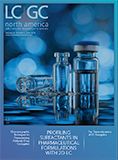HPLC Troubleshooting: Autosampler Contamination
LCGC North America
With autosamplers, we need to be extra careful to avoid contamination.
Although modern autosamplers may differ in their sampling principle (push to fill, pull to fill, integral loop, and so forth), they contain many similar features, including a needle for aspirating sample from the vial, a port to introduce the sample into a loop, and a valve that allows the sample plug to be automatically introduced into the mobile-phase flow. Although contamination may arise from several of the system components, the autosampler is arguably the most susceptible because it handles each sample in its nondiluted form and, in most cases, contains large surface areas and narrow-diameter tubing within the hydraulic pathways of the device. We need to be extra careful to avoid contamination issues, which can give rise to poor quantitative reproducibility (poor relative standard deviation between repeat injections of the same sample) and carryover from sample to sample that may lead to extraneous peaks within the chromatogram.
The sample needle is used to pierce the vial septum and withdraw the sample liquid, usually as a result of negative pressure created by the backstroke of a filling or metering pump. The needle is typically manufactured from passivated steel and contacts the sample on both its inside and outside surface. For this reason, it is important that both the inside and outside surfaces are properly washed between sample injections and care should be taken to program the wash cycle of the autosampler to effectively remove any contamination. You should consider the volume of wash solution with which the inside of the needle is flushed (at least 10x injection volume is recommended as a minimum) and the number of flushes (with washes in progressively cleaner solvents being optimal). Some instruments will allow wash solutions to be aspirated from different bottles, which may improve the efficiency of the wash. The wash solutions should be very carefully chosen and their eluotropic strength matched to that of the most highly retained analytes; for example, if the analyte is eluted at a composition of 60% organic, consider that concentration for the wash solution strength. Don't make the mistake of choosing a solvent that is highly solubilizing for the matrix, it is the analyte solubility that concerns us more here.
Wash bottle caps and injection ports (which typically contain a rubberized or polymeric seal), are also sources of contamination because the needle will pass through them after having recently been immersed in the sample. If contamination is suspected, it is good practice to change these components or thoroughly clean them in strong solvent before retesting. If it is feasible, it may be more beneficial to remove any seals or caps from wash bottles or vials to assess the impact on reducing contamination. Injection port seals should be well maintained and regularly replaced, and the nature of the injection port wash solvents (if fitted) should be considered in line with analyte solubility characteristics.
Perhaps the most insidious component for contamination is the injection valve itself, which contains a rotary seal that moves under pressure to "join" different hydraulic pathways within the autosampler, most notably to achieve injection of the loop contents into the mobile-phase flow. The rotor seal, which is the moving component and through which all sample material passes, is constructed from a plastic material, typically Vespel or Tefzel, and several external ports are connected to the various lines within the instrument. With use, the channels on the surface of the rotor seal may become scratched and roughened, which will promote the adsorption of analyte materials—this condition is especially problematic when the analyte has a greater affinity for the rotor seal material. One should ensure the correct rotor seal material is used (least adsorptive) and that the seal is inspected and maintained on a regular basis (as part of the preventative maintenance routine). Ensure that all connections into the valve are properly made and that there are no unswept volumes in any of the connections.
It is sometimes necessary to passivate the autosampler when dealing with analyte components that are known to be highly adsorptive on the metal surfaces (especially tubing) within the sampler, although this step has become increasingly unnecessary as manufacturers continue to improve their own passivation techniques. There are several chemical recipes to achieve passivation, and some involve flushing with various aqueous and organic solvents before treatment with solutions of strong acid. Your instrument manufacturer should be able to guide you through this process.

Understanding FDA Recommendations for N-Nitrosamine Impurity Levels
April 17th 2025We spoke with Josh Hoerner, general manager of Purisys, which specializes in a small volume custom synthesis and specialized controlled substance manufacturing, to gain his perspective on FDA’s recommendations for acceptable intake limits for N-nitrosamine impurities.












